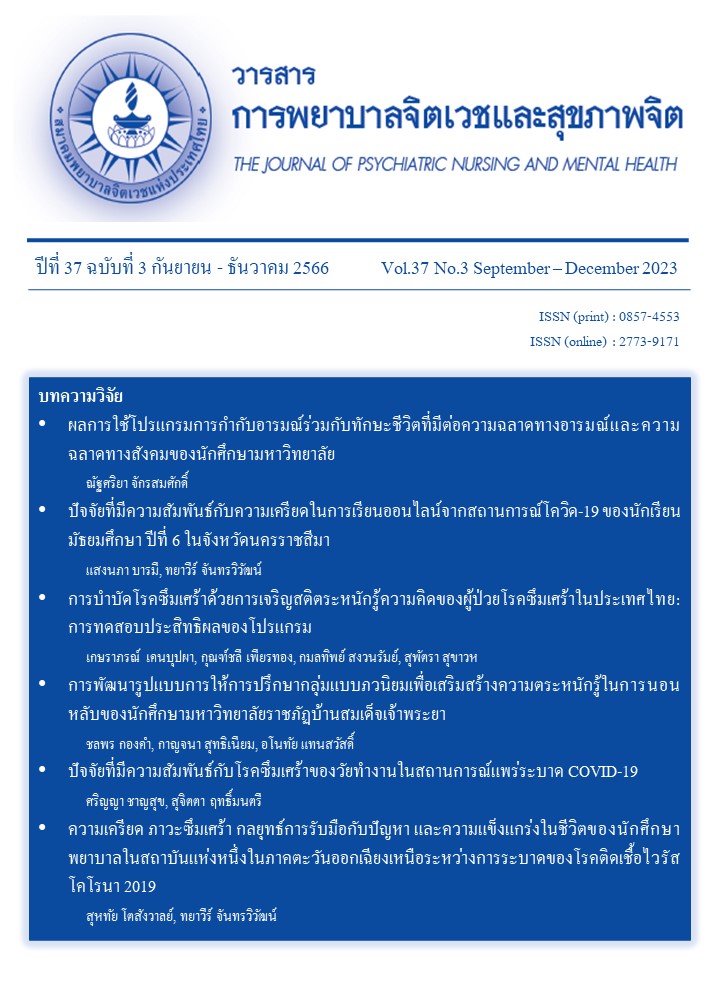FACTORS RELATED TO DEPRESSIVE DISORDER OF WORKING AGE PEOPLE IN THE SITUATION OF THE COVID-19 PANDEMIC
Main Article Content
Abstract
Objective: The objective was to screen for depressive disorders and study factors associated with depressive disorders of the working-age among the COVID-19 pandemic in Sam Prao Sub-district, Mueang district, Udonthani.
Methods: This study was conducted using a cross-sectional analytical study. Data was collected by face-to-face interviews with 400 working-age dwellers, aged 18-59 years who were selected by systematic random sampling, study period in March 2022. The tools were 1) a questionnaire consisting of general information and infection of COVID-19, and 2) a depression screening and assessment questionnaire (2Q, 9Q). Descriptive statistics and Logistic Regression.
Results: This study revealed that most working-age were female (69.2%), average age was 41.25, marriage (80.8%), high school graduation (59.8%), employee (59.5%), average income was around 10,643.75 per month, family member (83.7%), non-COVID-19 (99.2%), affected from COVID-19 pandemic: by maintain employment status (47.0%), and social supporting (99.2%). The working-age dwellers were at risk for depressive disorders by 30.0% and had a low level of depressive symptoms at 100%. It was found that a leadership role in the family (AOR = 2.659, 95% CI = 1.365 to 5.180, p< 0.05) had a statistically significant correlation with depressive disorders.
Conclusion: To prevent depressive disorders in working-age, Mental Health and Psychiatric Nurses or the health workforce in community settings should establish a prevention project, including caring program for working-age dwellers. Focusing on a leadership role in the family in order to decrease depressive disorder incidents.
Article Details

This work is licensed under a Creative Commons Attribution-NonCommercial-NoDerivatives 4.0 International License.
บทความที่ได้รับการตีพิมพ์แล้ว เป็นลิขสิทธิ์ของสมาคมพยาบาลจิตเวชแห่งประเทศไทย
References
กรมสุขภาพจิต กระทรวงสาธารณสุข. (6 กุมภาพันธ์ 2565). รายงานผู้ป่วยมารับบริการด้านจิตเวช. https://dmh.go.th/report/datacenter/hdc/reds.asp.
กรมสุขภาพจิต กระทรวงสาธารณสุข. (16 ธันวาคม 2564). แนวปฏิบัติการดูแลรักษาผู้ป่วย COVID-19 ที่มีภาวะ long COVID ในกลุ่มอาการทางสุขภาพจิต (Depression in Long COVID). https://mhso.dmh.go.th/fileupload/20220314 1114263113.pdf
กรมอนามัย กระทรวงสาธารณสุข. (20 มกราคม 2563). ระบบสารสนเทศสนับสนุนด้านการส่งเสริมสุขภาพและอนามัยสิ่งแวดล้อม: ปิรามิดประชากร ตำบลสามพร้าว ปี 2563. https://dashboard.anamai.moph.go.th/dashboard/populationpyramid/tambon?year=2020&tb=410114
กุลณ์วลี กิจวัฒนะโภคิน และธนาสิทธิ์ วิจิตราพันธ์. (2565). ความชุกและปัจจัยที่เกี่ยวข้องกับความกังวลความเครียดและภาวะซึมเศร้าในสถานการณ์การแพร่ระบาดของโรคโควิด 19 ของพนักงานโรงงานแห่งหนึ่งในอำเภอสันป่าตอง จังหวัดเชียงใหม่. วารสารวิชาการสาธารณสุข, 31(3), 393-403.
เขตสุขภาพที่ 8 กระทรวงสาธารณสุข. (31 พฤษภาคม 2565). รายงานสถานการณ์ COVID-19 วันที่ 31 พฤษภาคม 2565เวลา 16.00 น. เขตสุขภาพที่ 8 กระทรวงสาธารณสุข. https://r8way.moph.go.th/r8way/covid-19
คันธรส สุขกุล และ ปราโมทย์ วงศ์สวัสดิ์. (2562). ภาวะซึมเศร้าในประชากรวัยแรงงาน: ปัจจัยที่เกี่ยวข้องและแนวทางการดูแล. วารสารวิทยาลัยพยาบาลพระปกเกล้า จันทบุรี, 30(2), 229-238.
จันทนา เกิดบางแขม. (2564). รายงานการวิจัยเรื่องปัจจัยที่สัมพันธ์กับภาวะซึมเศร้าของแรงงานไทย ในเขตพื้นที่ระเบียงเศรษฐกิจ พิเศษภาคตะวันออก. ชลบุรี: คณะพยาบาลศาสตร์ มหาวิทยาลัยบูรพา.
ไชยวัฒน์ แพงพรมมา. (2565). ภาวะสุขภาพจิตและปัจจัยที่มีผลต่อการเกิดปัญหาสุขภาพจิตของประชาชน อำเภอหนองแสง จังหวัดอุดรธานี. วารสารอนามัยสิ่งแวดล้อม และสุขภาพชุมชน, 7(2), 69-81.
ณัฐกิต จรูญ. (30 กันยายน 2565). รายงานข้อมูลสถานการณ์การติดเชื้อโควิด-19 ณ วันศุกร์ที่ 30 กันยายน 2565.
ศูนย์ปฏิบัติการด้านนวัตกรรมการแพทย์และการวิจัยและพัฒนา ศูนย์บริหารสถานการณ์โควิด-19 (ศบค.) สำนักงานการวิจัยแห่งชาติ (วช.) กระทรวงการอุดมศึกษา วิทยาศาสตร์ วิจัยและนวัตกรรม. https://covid19.nrct.go.th/daily-report-30sep2022/
ธนาสิทธิ์ วิจิตราพันธ์. (2564) ความชุกและปัจจัยที่เกี่ยวข้องกับความเครียดและภาวะซึมเศร้าในสถานการณ์แพร่ระบาดโรคโควิด-19 ของประชาชนเขตคลินิกหมอครอบครัวบ้านทุ่งเสี้ยว อำเภอสันป่าตอง จังหวัดเชียงใหม่. วารสารสุขภาพจิตแห่งประเทศไทย, 29(1), 12-21.
ธรณินทร์ กองสุข. (2553). คู่มือผู้เข้ารับการอบรมแนวทางการจัดการโรคซึมเศร้าสำหรับแพทย์เวชปฏิบัติทั่วไปในสถานบริการระดับปฐมภูมิและทุติยภูมิ. โรงพิมพ์ศิริธรรมออฟเซ็ต.
วราพร ศรีภิรมย์, โสภิณ แสงอ่อน, พัชรินทร์ นินทจันทร์, วรภัทร รัตอาภา. (2563). ปัจจัยที่สัมพันธ์กับการปรับตัวในผู้ป่วยโรคซึมเศร้าหญิงวัยกลางคน. วารสารการพยาบาลจิตเวชและสุขภาพจิต, 34(3), 20-42.
สถาบันวิจัยประชากรและสังคม มหาวิทยาลัยมหิดล. (2564). รายงานสุขภาพคนไทยปี 2564. สถาบันวิจัยประชากรและสังคม มหาวิทยาลัยมหิดล.
สำนักข่าว HFocus เจาะลึกระบบสุขภาพ . (27 มีนาคม 2566). ภาวะสังคมไทย 2565 ป่วยซึมเศร้าพุ่งสูงแนวโน้มวัยรุ่น-วัยทำงานฆ่าตัวตายเพิ่มขึ้น 27 มีนาคม 2566. https://www.hfocus.org/content/2023/03/27358
สำนักงานสาธารณสุข จังหวัดอุดรธานี. (2 ธันวาคม 2563). รายงานประจำปี 2563. สำนักงานสาธารณสุข จังหวัดอุดรธานี. https://udo.moph.go.th/thepost/upload/fDAG pewyXpJ4pQYaLbUftR7p6i/oEYZuHniCHbgh3TxvEaVbti1Dm.pdf
สุวรรณา อรุณไพศาล, ธรณินทร์ กองสุข, ณรงค์ มณีทอน, เบญจลักษณ์ มณีทอน, กมลเนตร วรณเสวก, เกษราภรณ์ เคนบุปฝา, ธีราภา ธานี, จินตนา ลี้จงเพิ่มพูน. (2549). การพัฒนาและความเที่ยงตรงของแบบคัดกรองโรคซึมเศร้าชนิด 2 คำถาม ในชุมชนไทยอีสาน. วารสารสมาคมจิตแพทย์แห่งประเทศไทย, 50, 2-13.
Cohen S, & Wills TA. (1985). Stress, social support, and the buffering hypothesis. Psychological Bulletin, 98(2), 310-357.
Kim, S. S., Muntaner, C., Kim, H., Jeon, C. Y., & Perry, M. J. (2013). Gain of employment and depressive symptoms among previously unemployed workers: a longitudinal cohort study in South Korea. American journal of industrial medicine, 56(10), 1245-1250.
Krejcie, R. V., & Morgan, D. W. (1970). Determining sample size for research activities. Educational and Psychological Measurement, 30(3), 607-610.
Pearlin Leonard I. (1983). Role Strains and personal stress. In H B. Kaplan (Ed.), Psychosocial stress: Trends in theory and research (pp. 3-22). New York: Academic Press.
Orathai, P. (2006). Relationships between multiple roles, psychological well-being, skills and performance of government university administrators: an application of multi sample, non-recursive structural equation model. Journal of Research Methodology, 19, 291-314.
Salari, N., Hosseinian-Far, A., Jalali, R., Vaisi-Raygani, A., Rasoulpoor, S., Mohammadi, M., Rasoulpoor, S., & Khaledi-Paveh, B. (2020). Prevalence of stress, anxiety, depression among the general population during the COVID-19 pandemic: a systematic review and meta-analysis. Globalization and health, 16(1), 1-11.
World health Organization. WHO Coronavirus (COVID-19) Dashboard Report. 25 May 2023 https://covid19.who.int/
Yoon, H. J., Choi, J. W., Jang, S. Y., Lee, S. A., & Park, E. C. (2017). The effect of job loss on depressive symptoms: The results from the Korean Welfare Panel Study (2007-2013). International Journal of Social Psychiatry, 63(1), 57-62.

